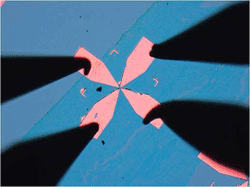Water may hold answer to graphene-based transistors
With the promise to open the door to using graphene in transistors, diodes, and nanoelectronics, and their applications, a team of researchers from Rensselaer Polytechnic Institute announced a new technique for using water to tune the band gap of the nanomaterial graphene. Because graphene is a zero-gap material, we do not see it in today’s chips and microprocessors that contain millions of transistors made from semiconductors with band gaps.

Shown is a graphene film on a silicon dioxide substrate that is being electrically tested using a four-point probe.
The team was able to create a band gap in graphene by exposing a graphene film to humidity. They demonstrated how to open a band gap in graphene based on the amount of water they adsorbed to one side of the material, precisely tuning the band gap to any value from 0 to 0.2 electron volts. This effect was fully reversible, so the band gap went back to zero when exposed to a vacuum — a technique so simple its only requirement is an enclosure where humidity can be precisely controlled.
Others also have shown how to create a band gap in graphene by using gas. However, it is the first time it is been done with water. The detailed results of this method were recently published by the journal Small . The research was supported by the Advanced Energy Consortium, NIST, and the U.S. Department of Energy Office of Basic Energy Sciences.
For more information on graphene research at Rensselaer, visit “Graphene Outperforms Carbon Nanotubes for Creating Stronger, More Crack-Resistant Materials” http://news.rpi.edu/update.do?artcenterkey=2715. Alternatively, contact Michael Mullaney at 518-276-6161 or e-mail mullan@rpi.edu.
Christina Nickolas
Researchers find key to opening a band gap in graphene
Advertisement
Learn more about Rensselaer Polytechnic Institute





